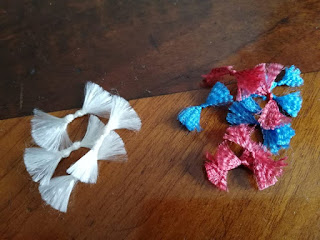There's a historic 200-years-Mary-Shelley-Frankenstein-ball and you
need a dress. Being a nerd who loves the novel, you put in as many hints
as possible: the style of the dress is slightly oriental, the
semi-transparent teal fabric is underlaid with a shimmering, silvery
fabric and decorated with silver metal trim, a silver crescent decorates
the headband and the front of the double-sided locket shows a river
scenery with a castle. Avid readers will understand the allusions ;)
 |
| Gathering the material. The picture does the silver fabric no credit. |
The
bodice pattern is based on the one from my white ball
gown, closing with buttons on the back; only this time I modified the
outer layer, which is smooth at the neckline and gathered at the bosom,
the pleats opening towards the neckline. I'm sure there's a ready-made
pattern for this out there somewhere, but again, I had four evenings
(plus a flight and an hour in Regent's Park) to complete the entire
dress, from pattern to trimming... The lining is made from the silver
rayon I used for the skirt of the shift.
The
sleeves are not puffed this time, but slightly gathered at the top and open, ending in a tip decorated with a small silver tassel.
The
skirt is attached to the gown beneath a sash of the same fabric, the edges (double sided where they hang down...) trimmed with approximately eight metres of silver braid, tassels at the ends. I did indeed use my usual amount of fabric for the skirt, three fabric widths with the sides of the front panel cut slightly aslant to make for a better fit. If you gather such an amount of fabric at the back of a dress, remember to cut the back neckline a little higher than intended, and the back side of the bodice a little shorter, as good old gravity will unite with the weight of the train and pull the dress a bit to the back when worn. Helps to lift the bosom to a perfect Regency level, by the way ;) And talking of the Regency waist, here's a most helpful guide to the slight changes in shape in each decade:
http://www.uvm.edu/~hag/regency/tips/
The
shift is a bodiced petticoat after my much-favoured push-up design. The skirt that's visible when dancing is made from a lovely, silver rayon which has a metallic sheen to it that's even visible through the upper layer. The bodice part is made from two layers of cotton for support. The teal dress does have a sash beneath the bust, but it's just decorative, not for actually keeping the dress in place
With this dress I finally found the perfect length for a train which isn't stepped on too often when dancing contredanses and still looks good when waltzing (btw it also is the first ballgown I ever made that was worn twice in two consecutive days, very economic!)
There's also a
shawl now to go with this dress, as I found matching wool when at a Frankenstein conference in Ingolstadt - some things come togehter so absurdly nicely you couldn't plan them any better! The pattern is the Aeolian Shawl from
knitty.com. There's some slightly glittery but unobtrusive synthetic thread spun into the wool that goes well with the idea of starry sky or electricity, and as also in previous centuries they did use metal threads together with wool for knitting, it's still period enough. The shawl is more like a decorative kerchief, covering the shoulders and the back, but doesn't reach past the sleeves of the dress. I bought more wool than needed with the intention of making matching fingerless mitts...
 |
| Wool in daylight, it's actually a shade darker. |
 |
| Finished shawl, it's a bit lighter actually. |





























